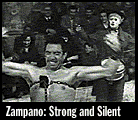
|
Fellini presents two sides of the same coin with some of his archetypal male figures. He shows men's idealized self-stereotype — strong, virile, masterful — while other images portray men as prisoners of their own sex roles. His idealized, male-fantasy image of Man as Master, Dominator of Women and King of his Domain is perhaps best represented in the 8-1/2 harem sequence. Here, Fellini's alter ego Marcello imagines himself as absolute master of all of the women he has ever desired, real or imagined. The absurdity of Marcello's fantasy brought me laughter, but as with all effective humor, his joke touched a grain of truth. In the dark recesses, away from the politically-correct facade, the sincere sensitivity of the intellect, lies the same old primal, sex-driven id longing to even the score for a lifetime of perceived rejections and maternal domination. The connection is brought even closer to home by Marcello's mild manner and largely 'enlightened' attitude toward women in his waking life.
City of Women's Dr. Xavier Zupercock is the early 80s version of Marcello's 50s-era harem master. While his fantasy-ideal masculinity is now besieged by women's increasing independence, Dr. Xavier wearily continues to hold out as master of his castle and as the suave, virile (but aging) conqueror of women. While the symbolism here was clear, it did not connect with the same effectiveness as Marcello's harem. Dr. Xavier's overt sexual prowess and the reliance on external virile trappings (guns, trophies of sexual conquest, etc.) did not play as well for me as Marcello's mind games. On the flip side, Zampano from La Strada is portrayed as a prisoner of the male stereotype. Strong and silent, virile and dominating, he can break chains with his chest muscles and exert his will over his woman. Yet, these 'virtues' doom him with an inability to communicate or even understand his feelings. The most powerful image for me here was a verbal one, rather than visual. The clown sympathetically compared Zampano with a dog — wanting to speak his love for his master, but by his nature, his feelings come out only as barks. Zampano's predicament speaks to society's stereotyping of young males — boys don't cry, boys are tough, boys act rather than talk. Here again, Fellini effectively touches upon an almost-universal male experience — one that I share and struggle against every day.
|
|
|






